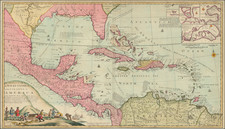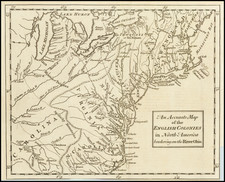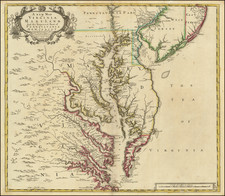Virginia Indians: The Noble Chiefs of Roanoke
Fine copper plate engraving showing Theodore De Bry's version of John White's painting.
The text translates as follows:
Leaders and nobles of the island and town of Roanoke have the hair on the top of their heads styled like a crest, similar to others. They let the rest of their hair grow like a woman and tie it into a knot behind their heads. They pierce their ears with threads through oyster shells and hang them from their ears, and from these or from rounded copper beads, or bone beads, they wear bracelets on their arms, neither pinching nor piercing: but they hang from their necks a torque, a sign of authority and excellence, consisting of thick oyster shells or copper beads or polished small bones. They cover their front and back from the navel to the middle of their thighs with elegantly prepared skin, adorned with fringes, like a woman. They also hold their arms crossed when walking or talking with others, a sign of prudence. Indeed, Roanoke is a very pleasant island, abundant in fish, due to the waters surrounding it.
In 1585, Governor John White, was part of a voyage from England to the Outer Banks of North Carolina under a plan of Sir Walter Raleigh to settle "Virginia." White was at Roanoke Island for about thirteen months before returning to England for more supplies. During this period he made a series of over seventy watercolor drawings of indigenous people, plants, and animals. The purpose of his drawings was to give those back home an accurate idea of the inhabitants and environment in the New World. The earliest images derived from White's original drawings were made in 1590, when Theodor De Bry made engravings from White's drawings to be printed in Thomas Hariot's account of the journey. Hariot, a mathematician, had also been part of the 1585 voyage.
Theodor de Bry (1528-1598) was a prominent Flemish engraver and publisher best known for his engravings of the New World. Born in Liege, de Bry hailed from the portion of Flanders then controlled by Spain. The de Brys were a family of jewelers and engravers, and young Theodor was trained in those artisanal trades.
As a Lutheran, however, his life and livelihood were threatened when the Spanish Inquisition cracked down on non-Catholics. De Bry was banished and his goods seized in 1570. He fled to Strasbourg, where he studied under the Huguenot engraver Etienne Delaune. He also traveled to Antwerp, London, and Frankfurt, where he settled with his family.
In 1590, de Bry began to publish his Les Grands Voyages, which would eventually stretch to thirty volumes released by de Bry and his two sons. The volumes contained not only important engraved images of the New World, the first many had seen of the geographic novelties, but also several important maps. He also published a collection focused on India Orientalis. Les Grands Voyages was published in German, Latin, French, and English, extending de Bry’s fame and his view of the New World.









![[ Carolinas & Georgia ] Virginiae Partis australis, et Floridae partis orientalis, interjacentiumqus regionum Nova Descriptio](https://storage.googleapis.com/raremaps/img/small/81554.jpg)
![(Mexican-Aztec Paintings) [Chapultepec and Coyotepec] Mexican Painting. 3738. Codex Vaticanus, page 130, Aglio 2 Vol.](https://storage.googleapis.com/raremaps/img/small/102306.jpg)

![Dominia Anglorum in America Septentrionali Specialibus Mappis Londini primum a Mollio… [4 maps--New England; Chesapeake, Georgia, Carolinas & Florida; and Nova Scotia…]](https://storage.googleapis.com/raremaps/img/small/60331.jpg)

